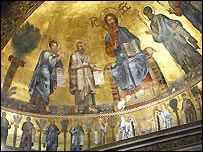Excavating the tomb of St. Paul in Rome
It is found that the tomb dates from about 390 AD in a crypt beneath a church in Rome. It is St. Paul's Cathedral, the largest church in Rome after St. Peter's Basilica.
The search in this area began in 2002 and ended last month. It is often said that St. Paul's grave is here, but it has long been hidden behind the altar of the Pope.

St Paul's Cathedral is the largest church in Rome (Photo: BBC)
For the past three years, archaeologists have excavated beneath the altar and moved to two giant marble slabs, and now, for the first time in nearly 1700 years, St. Paul's coffin is given to the public. they admire.
The Latin inscription engraved on the roof of the sarcophagus is " Paolo Apostolo Martyr ", meaning " Paul, apostolic apostle ", and it also has holes through which ancient pilgrims poke cloths. enter to be touched by the holy body.
St. Paul was the one who traveled a lot in Asia Minor, Greece and Rome in the first century, and the letters he sent to the early churches, found in the New Testament, showing that these were Christian thought may be the most influential.
St. Paul is said to have been beheaded by Emperor Nero in 65 AD.
The stone coffin will be allowed to be seen by the public for a while, however, the church has not yet rejected the possibility that one day they will allow it to be checked.
- Mysterious grave under Roman square
- Excavating Egyptian tomb 3,500 years contains mummies
- Excavating the tomb of Qin Shui Huang, discovering the animal world inside
- Found a thousand-year-old beef soup in a tomb
- Excavation of the tomb of Queen Cao Cao's grandson
- The truth falls back on the culprit who burned into Rome
- Excavating grave neck, finding Cao Cao remains?
- Mysterious labyrinth under Rome
- Image: Excavating the tomb of the post-Ming Dynasty
- Who is Paul Klee? What are the 'hard to define' works of Paul Klee?
- Recreate Rome in 1 day
- Find the oldest painting of the Lord's apostle
 Discovered an ancient centipede fossil 99 million years old
Discovered an ancient centipede fossil 99 million years old Discovered bat-like dinosaurs in China
Discovered bat-like dinosaurs in China Discovered a 200-year-old bronze cannon of the coast
Discovered a 200-year-old bronze cannon of the coast Discover 305 million-year-old spider fossils
Discover 305 million-year-old spider fossils